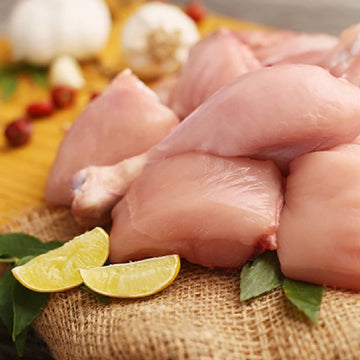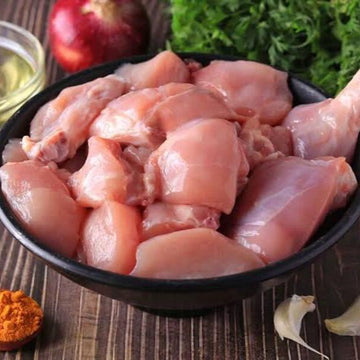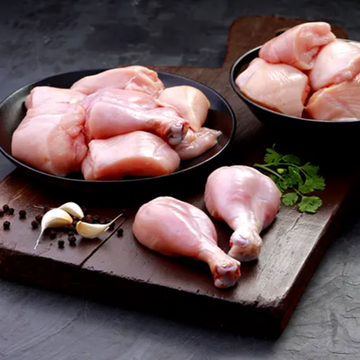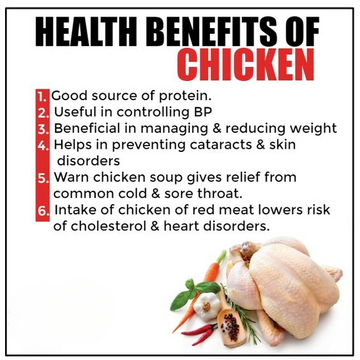Buy Chicken Normal Cut(چکن نارمل کٹینگ) 500 grams
Quantity:
Cash On Delivery
Easy Return & Refund Policy
24/7 Customer Support
Chickens are relatively large birds, active by day. The body is round, the legs are unfeathered in most breeds, and the wings are short. Wild junglefowl can fly; chickens and their flight muscles are too heavy to allow them to fly more than a short distance. Size and coloration vary widely between breeds. Adult chickens of both sexes have a fleshy crest on their heads called a comb or cockscomb, and hanging flaps of skin on either side under their beaks called wattles; combs and wattles are more prominent in males. Some breeds have a mutation that causes extra feathering under the face, giving the appearance of a beard
Chickens are relatively large birds, active by day. The body is round, the legs are unfeathered in most breeds, and the wings are short. Wild junglefowl can fly; chickens and their flight muscles are too heavy to allow them to fly more than a short distance. Size and coloration vary widely between breeds. Adult chickens of both sexes have a fleshy crest on their heads called a comb or cockscomb, and hanging flaps of skin on either side under their beaks called wattles; combs and wattles are more prominent in males. Some breeds have a mutation that causes extra feathering under the face, giving the appearance of a beard...
Chickens are omnivores. In the wild, they scratch at the soil to search for seeds, insects, and animals as large as lizards, small snakes, and young mice. A chicken may live for 5–10 years, depending on the breed.The world's oldest known chicken lived for 16 years.
Chickens are gregarious, living in flocks, and incubate eggs and raise young communally. Individual chickens dominate others, establishing a pecking order; dominant individuals take priority for access to food and nest sites. The concept of dominance, involving pecking, was described in female chickens by Thorleif Schjelderup-Ebbe in 1921 as the "pecking order". Male chickens tend to leap and use their claws in conflicts. Chickens are capable of mobbing and killing a weak or inexperienced predator, such as a young fox.
Benefits:
Rich in Protein: Chicken is a high-quality source of protein, which is essential for muscle growth and repair, as well as maintaining a healthy body composition.
Low in Fat: Chicken, especially chicken breast without skin, is low in saturated fat compared to red meats like beef or pork. It can be a healthier choice for those watching their fat intake.
Vitamins and Minerals: Chicken is a good source of important vitamins and minerals such as B vitamins (B6, B12, niacin), which are crucial for energy metabolism, nervous system function, and red blood cell production. It also contains minerals like phosphorus, which is important for bone health, and selenium, an antioxidant that helps protect cells from damage.
Supports Muscle Health: The protein content in chicken helps maintain muscle mass, which is important for overall strength and mobility, especially as we age.
Boosts Metabolism: Chicken contains amino acids that support metabolic function, helping the body convert nutrients into energy more efficiently.
Promotes Heart Health: Lean cuts of chicken, when prepared without added fats, can contribute to heart health by providing protein without excessive saturated fats that may raise cholesterol levels.
Versatile and Nutrient-Dense: Chicken can be prepared in various ways and easily combined with a wide range of ingredients, making it a versatile and nutrient-dense option in a balanced diet.
Nutritional Value:
Protein: Chicken breast is a rich source of high-quality protein, typically containing around 31 grams per 100 grams of cooked meat. Protein is essential for muscle growth, repair, and overall body function.
Low in Fat: Skinless, boneless chicken breast is relatively low in fat, with approximately 3.6 grams of fat per 100 grams. It is particularly low in saturated fat compared to other meats, making it a lean protein choice.
Vitamins: Chicken breast contains essential vitamins such as:
Vitamin B6: Important for metabolism, brain function, and nervous system health.
Vitamin B12: Necessary for red blood cell production and nerve function.
Niacin (Vitamin B3): Supports energy production and skin health.
Minerals: Chicken breast provides important minerals like:
Phosphorus: Essential for bone health and energy metabolism.
Selenium: Acts as an antioxidant, protecting cells from damage and supporting thyroid function.
Zinc: Important for immune function, wound healing, and protein synthesis.
Low Carbohydrates: Chicken breast is naturally low in carbohydrates, making it suitable for low-carb diets or people managing their blood sugar levels.
Calories: Skinless, boneless chicken breast is relatively low in calories, with approximately 165 calories per 100 grams, making it a nutrient-dense choice for those watching their calorie intake.








































































































